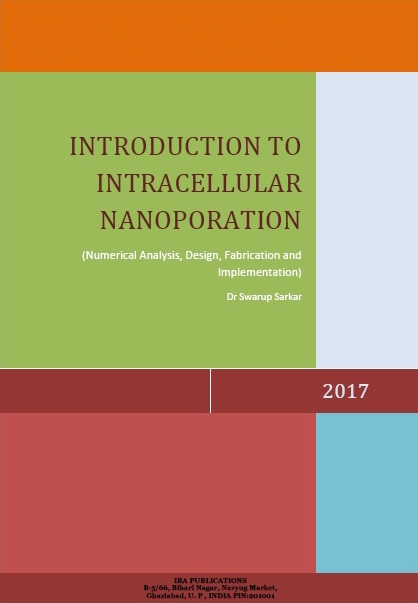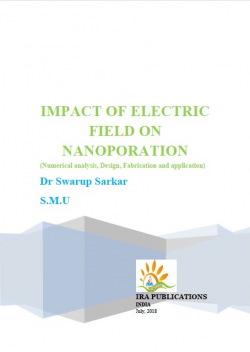Introduction to Intracellular Nanoporation (Numerical Analysis, Design, Fabrication and Implementation)
This book provides the information regarding the design and implementation of micro bio chip for nanoporation. This book provides the unique idea for medical and engineering students. It also helps the researchers for design and mathematical implementation of micro bio chip which is used for nanoporation. This book has been divided into five chapters. The description of the chapter as stated hare under. The first chapter gives a general introduction to electrical properties of osteoblast cell, microfloudics device. The second chapter deals with understanding of intra-organelle potential and window effects of Osteoblast cells. The main purpose here are to study the analytical and numerical approach of intra organelle membrane potential of multi-layer osteoblast like cell under a non-uniform micro-fluidic system under electrical stimuli and consequently to analyze effects of relevant optimization parameters. The optimum condition of threshold voltage and shifting of membrane potential from outer membrane to inner membrane has been reported that provides the idea about the nano pores formation within the intra organelle of the osteoblast cell. The third chapter has been focused on the numerical model of 3D nanoporative devices for intraorganelle nanoporation of osteoblast cell under Pico electric field. The characteristics of intraorganelle nanoporation of osteoblast cell under proposed nanopoarative device have been studied. The purpose of this chapter is to to analyze the behavior of nanopores developed into the intraorganelle of the osteoblast cells when subjected to application of pico electric fields. The fourth chapter highlights the different effective parameters of nanoporation such as intra organelle nanopore current, electrostatic pressure and membrane surface tension of a bi-layer osteoblast under electrical stimuli. The purpose of this chapter is to find out the numerical characterization of pore current, membrane pressure and membrane surface tension that can help us to solve the nano pore formation within the intraorganelle of osteoblast cell. The control of radius and density of nanopores of proposed devices has been studied. The fifth chapter sumerised the complete research work in the form of a conclusion.
As a whole this book deals with fundamental research about the behavior and modeling of intraorganelle nanoporation of osteoblast-like cells within 3D micro fluidic system under electrical stimulation. The results have the great impact on bio-medical application especially in drug delivery system for pharmacological treatment of different bone deasease including osteoporosis.
The major highlights of the book are:
a) Numerical and theoretical study of study intra-organelle nanoporation of different biological cell.
b) Theoretical explanation of Window effects.
c) Design, Fabrication and Implementation of 3D microdevice for intra organelle nanoporation.
d) Explore of the effect of Pressure, surface tension and rest potential on intracelluler nanoporation.
CONTENTS
CHAPTER 1: INTRODUCTION
1.1. Introduction
1.2 Literature review
1.2.1 Effect of electric field on biological cell
1.2.2 Effect of electric field on osteoblast cell
1.2.3 Electroporative micro fluidic devices
1.2.4 Intra organelle nano poration
1.3 Objectives of the thesis
1.4 Chapter organizations
CHAPTER 2: INTRA ORGANELLE POTENTIAL AND WINDOW EFFECTS OF OSTEOBLAST CELL
2.1 Introduction
2.2 Intra-organelle Potential under different electrical stimuli
2.2.1 Theory
2.2.1.1. Electrical properties of Osteoblast like bone cells
2.2.1.2 Nonlinear electrical dispersive model of osteoblast cell
2.2.1.3 Intra organelle transmembrane potential
2.2.1.3.1 Effect of electric pulse specification
2.2.1.3.2 Effect of electrode specification
2.2.1.3.3 Effect of microfloudic channel specification
2.2.1.3.4 Effect of micro fluid specification
2.2.1.4 Effect of medium resistances (𝑅𝑚) and of medium capacitances (Cm)
2.2.2 Simulation tool
2.2.3 Parameters and constant value used
2.2.4 Simulation Results
2.2.4.1 Electrical model of osteoblast cell.
2.2.4.2 Calculation of Intraorganelle potential
2.2.4.2.1 Effect of electric pulse field
2.2.4.2.2 Effect of electrode specification
2.2.4.2.3 Effect of channel specification
2.2.4.2.4 Effect of suspension of media
2.2.4.3 Role of different external parameters on intraorganelle potential
2.2.4.3.1 Effect of medium capacitances on membrane potential
2.2.4.4.2 Effect of medium resistances on transmembrane potential in various microelectrode
2.3 Frequency Domain analysis
2.3.1 Simulation results
2.4 Study of window effect
2.4.1 Simulation result of window effect.
2.4.1.1 Rectangular microelectrodes
2.4.1.2 Semicircular Electrode
2.4.1.3 Saw tooth Electrode
2.5 Conclusion
CHAPTER 3: INTRA ORGANELLE NANOPORATION USING ELECTRICAL STIMULI
3.1 Introduction
3.2 Nanoporative device simulation
3.3 Nanoporative device field simulation
3.4 Analytical study of intraorganelle nanoporation under different electrical stimuli
3.4.1 Theory of nanoporation
3.4.1.1 Radius of nanopores
3.4.1.2 Surface tension
3.4.1.3 Pore density
3.4.1.4 Ion uptake
3.4.2 Numerical simulation
3.4.3. Used parameter
3.4.4 Simulation results and observation
3.4.4.1 Intraorganelle potential
3.4.4.2 Nanopore radius
3.4.4.3 Nanopore density
3.4.4.4 Pore membrane surface tension
3.4.4.5 Ion uptake through nanopore
3.5 Conclusion
CHAPTER 4: ANALYSIS OF DIFFERENT EFFECTIVE PARAMETERS FOR INTRAORGANELLE NANOPORATION UNDER ELECTRICAL STIMULI
4.1 Introduction
4.2 Theory
4.2.1 Pulse electric field
4.2.2 Micro Electrode
4.2.3 Micro Fluidic Channel
4.2.4 Suspension Media
4.3 Simulation Results and Analysis
4.3.1 Pore current
4.3.1.1 Effect of Pulse
4.3.1.2 Effect of Electrode Specification
4.3.1.3 Effect of Channel Specification
4.3.1.4 Effect of Suspension of Media
4.3.2 Membrane Pressure
4.3.2.1 Effect of pulse
4.3.2.2 Effect of Electrode specification
4.3.2.3 Effect of Channel specification
4.3.2.4 Effect of suspension of media
4.3.3 Surface tension
4.3.3.1 Effect of pulse
4.3.3.2 Effect of Electrode specification
4.3.3.3 Effect ofChannel specification
4.3.3.4 Effect of suspension of media
4.4 Discussions
4.4.1 Pore current
4.4.2 Pressure
4.4.3 Surface tension
4.5 Effect of Pressure, Surface Tension and Rest potential on Intraorganelle nanoporation
4.5.1. Effect of pressure
4.5.1.1 Effect of pressure on free energy of pore
4.5.1.2 Effect of pressure on density of pore
4.5.2 Effect of surface tension
4.5.2.1 Effect of surface tension on radius of nanopores
4.5.2.2 Effect of surface tension on density of pores
4.5.3 Effect of Rest Potential
4.5.3.1 Effect of rest potential on free energy of pore
4.5.3.2 Effect of rest potential on radius of nanopores
4.5.3.3 Effect of rest potential on density of pores
4.6 Conclusion
CHAPTER 5: CONCLUSIONS AND FUTURE SCOPE
5.1 Conclusion
5.2 Future Works


 are now available. As low
as ₹120.00 per month.
are now available. As low
as ₹120.00 per month.














